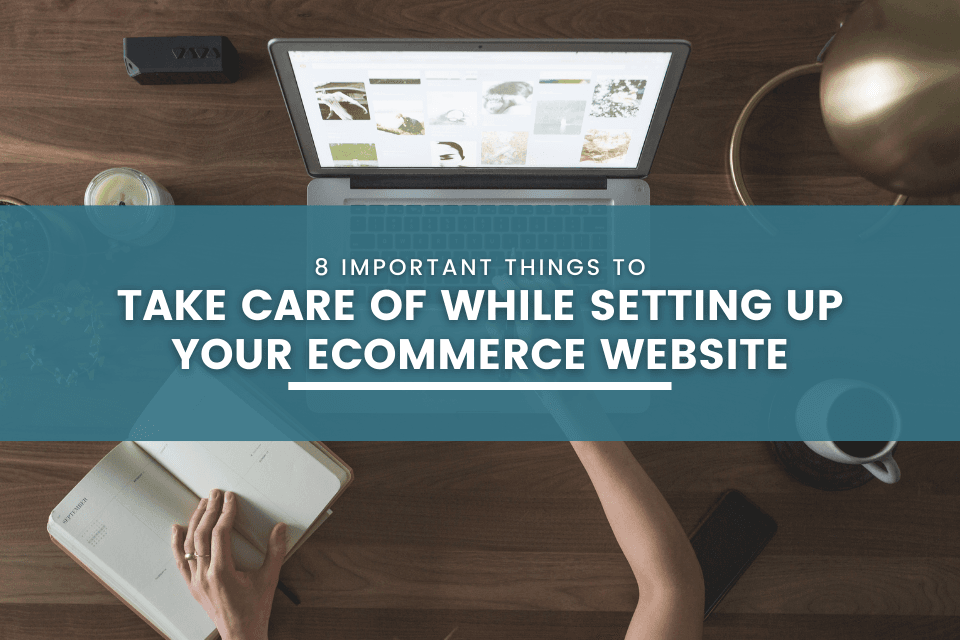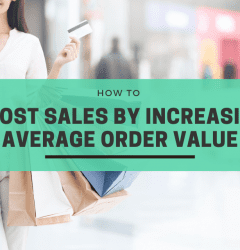This website uses cookies so that we can provide you with the best user experience possible. Cookie information is stored in your browser and performs functions such as recognising you when you return to our website and helping our team to understand which sections of the website you find most interesting and useful.
08 Feb

8 Important Things to Take Care of While Setting Up Your eCommerce Website
With over 2 billion digital buyers globally, developing an eСommerce website is a great, if not essential, business idea. But creating a good online store that will stand out amongst the sea of competitors involves more than just pretty design and good SEO.
Admittedly, there are no universal features or design options that will guarantee your online store’s success, however, when it comes to creating an online store, there are a few common necessities and even desired features that should not be overlooked.
If you’re thinking about starting an eCommerce business and selling products online, we’ve rounded up a list of features to keep in mind to make sure your web store is a success.
1) Payment Options
When you’re just starting out with an eCommerce website, including all potential payment alternatives can be too much, but merely offering one limits you to customers who use that option. PayPal, Apple Pay, Amazon Pay, Google Pay, American Express, Stripe, Square, Visa, Mastercard, and 2Checkout are the most popular payment options, according to Hostgator.
Apart from the online payment options, you really need to decide whether Cash on Delivery (COD) is crucial for your business or not. For COD specifically, some things to consider are:
- How to pick-up the cash after delivery?
- How to refund the money in case of returns?
- Do you want to set some minimum order value in order to provide a COD option?
- Verifying the customer for the COD payments to avoid misuse.
When managing transactions at LuckyWins Casino, it’s crucial to consider various factors that can streamline your payment process and enhance the overall customer experience. By aligning payment options with your players’ preferences, you not only ensure a smoother transaction but also raise their motivation to engage with the casino. This thoughtful approach can lead to increased sales and player retention in the long run. Offering diverse payment methods, for example, can cater to different customer needs, creating a more welcoming environment at LuckyWins Casino and ultimately driving greater satisfaction and loyalty among your patrons.
2) Shipping Process and Partners
Your shipping process should be set up by keeping several things in mind such as the product type, delivery time, etc. For example, if you are manufacturing marbles and tiles, you need to be careful while shipping them as they are easily breakable.
Some other things to consider are as follows:
- You will also need to pay close attention to the shipping carriers required to deliver to your customers.
- When choosing a shipping carrier, think about the goods you are going to ship and how much they can weigh as well as their type, which locations you will be shipping to, the costs involved, and what tracking options will be available. For example, you are selling plywood. The products are bulky and a normal courier won’t be able to handle them. Also, the cost of shipping a single plywood would be very high. In this case, either you might need to make bundles or plan for delivering them through a local dealer/distributor.
- The underlying idea is to present your customers with different shipping options covering both shipping speed and varying price points to provide as many options as possible.
- Another important thing to keep in mind is that most shipping companies work with some restrictions. Typically, all the companies have a similar list of restricted products. Hence, it is recommended to have a look at these in case you are planning to ship internationally.
3) Website Safety and Security
As an eCommerce business, you store a large amount of data about your products and the users that register to buy on your site. Any breach of this data puts your business at risk; your leads’ contact information could be stolen and sold, or you could permanently lose essential data.
Not too long ago, Google started flagging websites that did not have an SSL certificate and HTTPS protocol. These aren’t just suggestions or warnings; without these two components, users won’t be able to access websites, and if your certificate expires, you risk losing possible orders.
Some must-have eCommerce security features to consider are:
- SSL certificate: A secure connection between a user and a website is established using an SSL certificate. Before entrusting their personal information to an online store, users tend to look for HTTPS and a green lock in the address bar. Choose an SSL certificate provider with a well-known name. The enterprise eCommerce giants almost always use Symantec.
- Two-factor authentication: By requiring a username/password as well as a system-generated code given through email or text, it adds an extra layer of security.
- Use a firewall: Allows authorized traffic while preventing malicious traffic through a gateway or wall between two networks.
- Privacy policy link in footer: Addresses the website’s privacy policies and assures customers that their personal information will not be shared with third parties.
- GDPR implementation: The European Union’s General Data Protection Regulation (GDPR) aims to enhance individuals’ control and rights over their personal data and to simplify the regulatory environment for international business. In order to be globally relevant, businesses need to be compliant with the law and demonstrate competitiveness.
- AdminURL structure: The URL structure of the backend which gives admins the access to manage and update the website should be non-guessable. For example, instead of xyz.com/admin you should consider xyz.com/adminsji. Adding a set of orbit characters to the URL makes it much harder for bots that might be looking to gain unauthorized access to your website.
4) Website Search and Filtering Functionality
Setting up filters within your product catalog is also a good way to provide your users with a quick and convenient way to navigate through your products.
Major challenges that sellers face are :
- Deciding on the facets for filtering: Users will be able to find products and content faster thanks to a comprehensive set of filters and facets. Too many irrelevant options, on the other hand, can be confusing. You should take time to carefully select the categories and values and make sure to tailor your facets to your specific business segment and users. Consider the following questions before deciding the appropriate facets for your eCommerce store:
- What are the most important facets? For example, you are selling wardrobes and you haven’t thought about the number of doors, door type or any other such facets. Then, without this data for each SKU, you won’t be able to implement that facet as a filter later on.
- Whether the data of those facets are available or not?
- Whether the filters will be a range or single value? For example – price, number of ratings or any such properties are different for each SKU. And, if these filters are implemented as single values, it will lead to a huge number of filter values. Ultimately, this will make the filters unusable for the customers.
- Whether multi-select is suitable or single select?
- In the case of multi-select, whether you want to allow AND or OR sorting?
- Deciding on the facets for sorting: The majority of active users may be able to drill down to find exactly what they’re looking for using filters and facets. More passive or new users, on the other hand, will most likely want to explore larger sets of content. Sorting is an essential part of this process because it allows users to order content based on the factors that are most important to them, increasing the likelihood of finding relevant results. Therefore, it is critical for you to select the appropriate facets for sorting.
5) Customer Support and Assistance
Customer support assists customers with shipping, payment, returns, and other issues.
For customer support and contact, some vital aspects to consider are:
- Whether you want to have 24/7 customer support or for a limited time?
- Whether you want to include other options along with phone numbers such as WhatsApp number, Facebook Messenger chat button, or not? Also, while including the phone number, you must also think of whose number you are putting, especially, when you do not have a dedicated customer service team. A team member can pick up the call in the defined time, otherwise, the customers will become frustrated and the brand will lose credibility.
- Do you want to deploy a live chat option or not?
It is vital for you to think about the above questions based on your business needs and clearly showcase them on your website.
6) Guest Checkout
Before making a purchase, many eCommerce sites now require users to register and create an account. Although this is very useful because it allows you to communicate with, follow-up with, and track your customers, it is not something that customers want to do. Customers want to make every transaction as quick and anonymous as possible.
Customers don’t have to fill out pages of personal information before making a purchase with guest check-outs. Guest checkouts, according to experts, help boost conversion rates by removing the barrier (signing up/registering) so that more people can order from you.
For effectively implementing guest checkout on your eCommerce website, consider the following aspects:
- The first aspect to keep-in mind is customer verification. Verify your customer’s mobile number and address before shipping the product to them. This process is very important, especially for COD orders. Otherwise, the guest-checkout feature can be used for fake orders and scam.
- The second critical factor is the “Cancel order” option. You should think of a way to provide them an option to cancel the order. This way the customers who have opted for guest checkout can cancel their order easily.
- Last and the most important element is order tracking. It is crucial for you to provide order tracking to your customers you have ordered via guest checkout. This improves client satisfaction as they will be able to track their orders effectively.
7) Catalog Content (Including Pictures & Videos)
The days of posting a single photo with a few bullet points and a price tag are long gone. Shoppers want to see the product from various perspectives and people using it in various settings. They want to be able to zoom in on the product and get a feel for it.
Technical considerations for images are crucial. Images that don’t load or take too long to load will see a consumer drop-off rate of 39%, according to Adobe.
Some important factors are:
- Multiple photos per product should be displayed on ecommerce websites.
- The photos need to be high-resolution and optimized for page load.
- Make sure you have a sufficient lineup of images and videos ready to be used on your website well in advance. This is crucial as it will require a different skill set and is generally time-consuming. Therefore, if the planning is done at the last moment, it can delay going live.
8) Return Policy
Return policies are an essential feature of any eCommerce website. Some crucial things to consider are:
- Whether you want to allow returns and refunds?
- If yes, then, who is going to pick-up the returns?
- What will be the process of refunding the customer? If the order was COD, how will you refund the cash? Do you want to refund cash or in a bank account? How do you reconcile the same?
Your return policy should be well-written or illustrated and easily visible. This is another trust-building feature of online selling. It assures customers that if they are dissatisfied or just require a different size, the brand is there for them.
Final Thoughts
It would be an understatement to say that there’s a lot to think about when creating an eCommerce website. Based on our experience, we know that there are a host of features, nuances, and technology you’ll need to create a convenient, functional, high-performance online store that will attract customers. Even if you use WordPress, eCommerce plugins, or software like Shopify, it’s not an easy task.
Industries Served
United States
India













